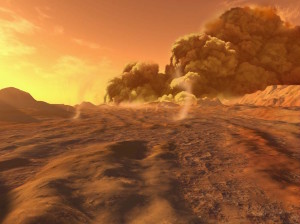Dust Storm On Mars
Now this is really bad weather – a dust storm that doesn’t just cover an area, or even a hemisphere, but the entire planet. During summer in the Red Planet’s southern hemisphere, when Mars is at its closest point to the Sun, solar heating can drive immense storms that blow up red dust and can obscure the surface for months.
In 1971, when Mariner 9 arrived at Mars, it found the whole planet hidden under a veil of dust, with only the volcano Olympus Mons visible. More recently, the Mars Exploration Rovers Spirit and Opportunity would struggle to survive in dust storms as the Sun’s light was blocked and their solar panels covered by a coating of dust.
On Earth, moisture arms swirling storms, but on Mars there is only dust. Normally most of the dust is on the ground, but some is found in the atmosphere, where it scatters sunlight and makes the sky appear pinky-red.
 When Mars is at its hottest – still cold enough to freeze water – the atmospheric dust can absorb the energy of the sunlight, which causes warm pockets of air to rapidly move towards colder, low-pressure regions, generating winds up to 45 metres per second (162 kilometres per hour or 100 miles per hour) that begin to pick up dust particles from the ground, adding to the atmospheric dust content and increasing heating, pushing the winds harder and faster until the atmosphere is filled by dust.
When Mars is at its hottest – still cold enough to freeze water – the atmospheric dust can absorb the energy of the sunlight, which causes warm pockets of air to rapidly move towards colder, low-pressure regions, generating winds up to 45 metres per second (162 kilometres per hour or 100 miles per hour) that begin to pick up dust particles from the ground, adding to the atmospheric dust content and increasing heating, pushing the winds harder and faster until the atmosphere is filled by dust.
And then, just as quickly, the storm can die down. Perhaps by blocking the sunlight, the surface of Mars grows cooler, allowing some of the dust to begin sinking out of the atmosphere. Not all dust storms swallow the entire planet – some are more localized events. However, were you to be on the surface during a dust storm, other than the sky darkening and a fine coating of dust settling over you, the atmosphere is so thin that you’d barely notice the wind or the scouring dust.

